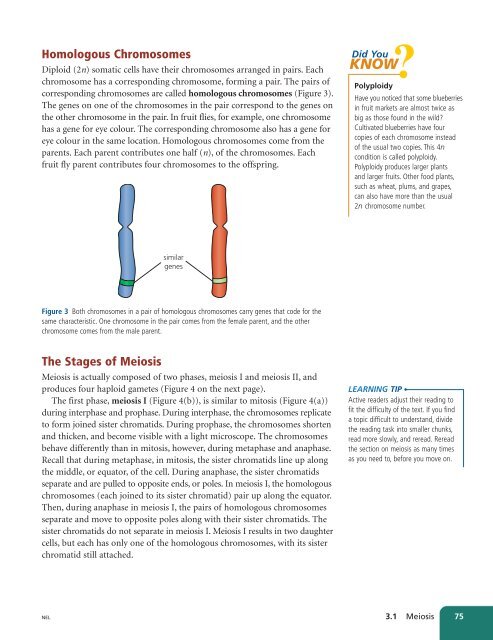Unit A Reproduction
Unit A Reproduction
Unit A Reproduction
You also want an ePaper? Increase the reach of your titles
YUMPU automatically turns print PDFs into web optimized ePapers that Google loves.
Homologous Chromosomes<br />
Diploid (2n) somatic cells have their chromosomes arranged in pairs. Each<br />
chromosome has a corresponding chromosome, forming a pair. The pairs of<br />
corresponding chromosomes are called homologous chromosomes (Figure 3).<br />
The genes on one of the chromosomes in the pair correspond to the genes on<br />
the other chromosome in the pair. In fruit flies, for example, one chromosome<br />
has a gene for eye colour. The corresponding chromosome also has a gene for<br />
eye colour in the same location. Homologous chromosomes come from the<br />
parents. Each parent contributes one half (n), of the chromosomes. Each<br />
fruit fly parent contributes four chromosomes to the offspring.<br />
Did You<br />
KNOW?<br />
Polyploidy<br />
Have you noticed that some blueberries<br />
in fruit markets are almost twice as<br />
big as those found in the wild?<br />
Cultivated blueberries have four<br />
copies of each chromosome instead<br />
of the usual two copies. This 4n<br />
condition is called polyploidy.<br />
Polyploidy produces larger plants<br />
and larger fruits. Other food plants,<br />
such as wheat, plums, and grapes,<br />
can also have more than the usual<br />
2n chromosome number.<br />
similar<br />
genes<br />
Figure 3 Both chromosomes in a pair of homologous chromosomes carry genes that code for the<br />
same characteristic. One chromosome in the pair comes from the female parent, and the other<br />
chromosome comes from the male parent.<br />
The Stages of Meiosis<br />
Meiosis is actually composed of two phases, meiosis I and meiosis II, and<br />
produces four haploid gametes (Figure 4 on the next page).<br />
The first phase, meiosis I (Figure 4(b)), is similar to mitosis (Figure 4(a))<br />
during interphase and prophase. During interphase, the chromosomes replicate<br />
to form joined sister chromatids. During prophase, the chromosomes shorten<br />
and thicken, and become visible with a light microscope. The chromosomes<br />
behave differently than in mitosis, however, during metaphase and anaphase.<br />
Recall that during metaphase, in mitosis, the sister chromatids line up along<br />
the middle, or equator, of the cell. During anaphase, the sister chromatids<br />
separate and are pulled to opposite ends, or poles. In meiosis I, the homologous<br />
chromosomes (each joined to its sister chromatid) pair up along the equator.<br />
Then, during anaphase in meiosis I, the pairs of homologous chromosomes<br />
separate and move to opposite poles along with their sister chromatids. The<br />
sister chromatids do not separate in meiosis I. Meiosis I results in two daughter<br />
cells, but each has only one of the homologous chromosomes, with its sister<br />
chromatid still attached.<br />
LEARNING TIP<br />
Active readers adjust their reading to<br />
fit the difficulty of the text. If you find<br />
a topic difficult to understand, divide<br />
the reading task into smaller chunks,<br />
read more slowly, and reread. Reread<br />
the section on meiosis as many times<br />
as you need to, before you move on.<br />
NEL<br />
3.1 Meiosis 75

















